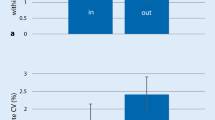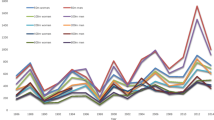Abstract
Little is known about the evolution of career pathways among young athletes. This study aims primarily to explore how consistent career pathways develop among age group swimmers. Each of three sub-cohorts of German 11-year-olds ranked top 100 from 2004 to 2006 were followed, as measured by their best Fédération Internationale de Natation (FINA) point score, for 8 years up to the age of 18 years of age. Careers were reckoned as consistent when athletes still appeared in the top 100 at 18. The degree of consistency of performance was measured by the number of years which those who started in the top 100, remained in the top 100. Correlational analysis examined the relationships between success at 11 and the consistency profile over 8 years. These results showed weak consistency of performance among age group swimmers. Only 33% of those ranked among the top 100 at 11 years were also ranked in the top 100 at 18, and only 23% were consistently ranked. The best performance in a certain event, stroke or distance category showed no significant correlation or a low level of correlation with consistency. The results confirm that we still know too little about the consequences of talent identification, talent development and long-term athlete development programmes.
Zusammenfassung
Es ist bislang nur wenig darüber bekannt, wie sich Karrieren im Nachwuchsleistungssport entwickeln. Diese Studie beschäftigt sich schwerpunktmäßig mit der Kontinuität im Nachwuchsleistungsschwimmen. Drei Kohorten von Athletinnen und Athleten, die mit 11 Jahren (zwischen 2004 und 2006) in den Jahrgangsbestenlisten des Deutschen Schwimmverbands vertreten waren, wurden in ihrem weiteren Karriereverlauf über 8 Jahre bis zu einem Alter von 18 Jahren verfolgt. Karrieren wurden als kontinuierlich gewertet, wenn Athletinnen und Athleten auch mit 18 Jahren noch in den Jahrgangsbestenlisten vertreten waren. Der Grad der Kontinuität wurde an der Summe der Jahre gemessen, die sie zwischen 11 und 18 Jahren in den Listen platziert waren. In der statistischen Analyse wurde der Zusammenhang zwischen der Leistung mit 11 Jahren (gemessen in Fédération Internationale de Natation[FINA]-Punkten) und dem Kontinuitätsprofil getestet. Die Ergebnisse zeigen, dass Karrieren im Nachwuchsleistungsschwimmen wenig kontinuierlich sind. Nur 33 % der platzierten 11-Jährigen waren noch mit 18 Jahren in den Jahrgangsbestenlisten vertreten und nur 23 % waren dabei in jedem einzelnen Jahr unter den Top 100 ihres Jahrgangs platziert. Die höchsten erzielten FINA-Punkte waren kein signifikanter Prädiktor für die Kontinuität der Athletinnen und Athleten, weder auf einer der 13 betrachteten Wettkampfstrecken noch in einer bestimmten Lage oder Distanz. Die Ergebnisse zeigen, dass immer noch wenig über die Konsequenzen der Talentidentifikation, Talententwicklung und Gestaltung eines nachhaltigen Leistungsaufbaus bekannt ist.


Similar content being viewed by others
References
Abbott, A., Collins, D., Martindale, R. J., & Sowerby, K. (2002). Talent identification and development: an academic review. Edinburgh: SportScotland.
Allen, S. V., & Hopkins, W. G. (2015). Age of peak competitive performance of elite athletes: a systematic review. Sports Medicine, 45(10), 1431–1441. https://doi.org/10.1007/s40279-015-0354-3.
Allen, S. V., Vandenbogaerde, T. J., & Hopkins, W. G. (2014). Career performance trajectories of Olympic swimmers: benchmarks for talent development. Eur J Sport Sci, 14(7), 643–651. https://doi.org/10.1080/17461391.2014.893020.
Arellano, R. (2010). Interpreting and implementing the long term athlete development model: English swimming coaches’ views on the (swimming) LTAD in practice a commentary. International Journal of Sports Science & Coaching, 5(3), 413–419.
ASA (2013). Long term athlete development—related to the journey through swimming. http://www.swimming.org/assets/uploads/library/NOV13_Addition_SuccessisLongTerm-_Final__With_BAGCAT_Rules_2010_2.pdf. Accessed 13.05.2017.
Bailey, R., Collins, D., Ford, P., MacNamara, Á., Toms, M., & Pearce, G. (2010). Participant development in sport: an academic review. Sports Coach UK, 4, 1–134.
Barreiros, A., Côté, J., & Fonseca, A. M. (2014). From early to adult sport success: analysing athletes’ progression in national squads. European Journal of Sport Science, 14(sup1), S178–S182. https://doi.org/10.1080/17461391.2012.671368?needAccess=true.
Bühner, M., & Ziegler, M. (2009). Statistik für Psychologen und Sozialwissenschaftler. München: Pearson.
Cobley, S., Abbott, S., Dogramaci, S., Kable, A., Salter, J., Hintermann, M., & Romann, M. (2017). Transient relative age effects across annual age groups in national level Australian swimming. Journal of science and medicine in sport, 21(8), 839–845.
Cohen, J. (1992). A power primer. Psychological bulletin, 112(1), 155.
Costa, A. M., Marques, M. C., Louro, H., Ferreira, S. S., & Marinho, D. A. (2013). The relative age effect among elite youth competitive swimmers. European journal of sport science, 13(5), 437–444. https://doi.org/10.1080/17461391.2012.742571?needAccess=true.
Costa, M. J., Bragada, J. A., Marinho, D. A., Reis, V. M., Silva, A. J., & Barbosa, T. M. (2014). Longitudinal assessment of swimming performance in the 200‑m Freestyle event. The Open Sports Sciences Journal, 3(1), 92–94.
Costa, M. J., Marinho, D. A., Bragada, J. A., Silva, A. J., & Barbosa, T. M. (2011). Stability of elite freestyle performance from childhood to adulthood. J Sports Sci, 29(11), 1183–1189. https://doi.org/10.1080/02640414.2011.587196.
Costa, M. J., Marinho, D. A., Reis, V. M., Silva, A. J., Bragada, J. A., & Barbosa, T. M. (2010). Stability and prediction of 100‑m breaststroke performance during elite swimmers career. In XIth International Symposium for Biomechanics and Medicine in Swimming, Oslo.
De Bosscher, V., & De Rycke, J. (2017). Talent development programmes: a retrospective analysis of the age and support services for talented athletes in 15 nations. European Sport Management Quarterly, 17(5), 590–609.
Deprez, D., Coutts, A. J., Fransen, J., Deconinck, F., Lenoir, M., Vaeyens, R., & Philippaerts, R. (2013). Relative Age, biological maturation and anaerobic characteristics in elite youth soccer players. International Journal of Sports Medicine, 34(10), 897–903. https://doi.org/10.1055/s-0032-1333262.
DSV (2014). Bestenlisten des DSV. http://www.dsv.de/schwimmen/wettkampf-national/bestenlisten/. Accessed 12.06.2014.
FINA (2018). FINA Points 2018. http://www.fina.org/content/fina-points. Accessed 17.09.2018.
Ford, P., De Ste Croix, M., Lloyd, R., Meyers, R., Moosavi, M., Oliver, J., Till, K., & Williams, C. (2011). The long-term athlete development model: Physiological evidence and application. Journal of Sports Sciences, 29(4), 389–402. https://doi.org/10.1080/02640414.2010.536849.
Gulbin, J., Weissensteiner, J., Oldenziel, K., & Gagné, F. (2013). Patterns of performance development in elite athletes. European Journal of Sport Science, 13(6), 605–614. https://doi.org/10.1080/17461391.2012.756542.
Güllich, A. (2014). Selection, de-selection and progression in German football talent promotion. European journal of sport science, 14(06), 530–537. https://doi.org/10.1080/17461391.2013.858371.
Güllich, A., & Emrich, E. (2006). Evaluation of the support of young athletes in the elite sports system. European Journal for Sport and Society, 3(2), 85–108. https://doi.org/10.1080/16138171.2006.11687783.
Güllich, A., & Emrich, E. (2014). Considering long-term sustainability in the development of world class success. European Journal of Sport Science, 14(1), 383–397. https://doi.org/10.1080/17461391.2012.706320?needAccess=true.
Güllich, A., Pitsch, W., Papathanassiou, V., & Emrich, E. (2000). Zur Rolle von Trainingsempfehlungen im Nachwuchsleistungssport. Teil 1: Das synthetische Apriori im Leistungssport. Leistungssport, 30(5), 45–52.
Helsen, W. F., Winckel, J. V., & Williams, A. M. (2005). The relative age effect in youth soccer across Europe. Brain research, 23(6), 629–636. https://doi.org/10.1080/02640410400021310.
Holt, N. L. (2010). Interpreting and implementing the long term athlete development model: English swimming coaches’ views on the (swimming) LTAD in practice: a commentary. International Journal of Sports Science & Coaching, 5(3), 421–424.
Lang, M., & Light, R. (2010). Interpreting and implementing the long term athlete development model: English swimming coaches’ views on the (swimming) LTAD in practice. International Journal of Sports Science & Coaching, 5(3), 389–402.
Musch, J., & Grodin, S. (2001). Unequal competition as an impediment to personal development: a review of the relative Age effect in sport. Developmental Review, 21(2), 147–167. https://doi.org/10.1006/drev.2000.0516.
Radford, K., Moss, A., & Richard, M. (2008). Long term athlete development. https://www.swimming.ca/content/uploads/2015/06/ltad_en.pdf. Accessed 13.05.2017.
Raleigh, V. (2011). Long term development in swimming. http://www.swimming.org.au/visageimages/1_SAL/Swimmers__Parents/Long_term_development_in_Swimming.pdf. Accessed 13.05.2017.
Rudolph, K. (2015). Nachwuchskonzeption Schwimmen 2020 – Vom Grundlagen- bis zum Anschlusstraining [Long-term Athlete Development in German Swimming 2020—from junior to elite level]. Kassel: Deutscher Schwimmverband e. V.
Schumacher, Y. O., Mroz, R., Mueller, P., Schmid, A., & Ruecker, G. (2006). Success in elite cycling: a prospective and retrospective analysis of race results. Journal of Sports Sciences, 24(11), 1149–1156.
Sokolovas, G. (2006). Analysis of USA swimming’s all-time top 100 times. In Proceedings of the Xth international symposium on biomechanics and medicine in swimming, Porto, POR.
Treffene, B. (2010). Interpreting and implementing the long term athlete development model: English swimming coaches’ views on the (swimming) LTAD in practice: a commentary. International Journal of Sports Science & Coaching, 5(3), 407–411.
Trewin, C. B., Hopkins, W. G., & Pyne, D. B. (2004). Relationship between world-ranking and Olympic performance of swimmers. Journal of Sports Sciences, 22(4), 339–345. https://doi.org/10.1080/02640410310001641610.
Van Hoecke, J., & De Knop, P. (2006). Development of a relevant quality system for gymnastics clubs: an application of the principles of total quality and service management in traditionally organised sport. International Journal of Sport Management and Marketing, 1(4), 359–377.
Wattie, N., & Baker, J. (2017). Why conceptualizations of talent matter. In J. Baker, S. Cobley, J. Schorer & N. Wattie (Eds.), Routledge handbook of talent identification and development in sport (pp. 69–79). New York: Routledge.
Wharton, K. (2011). The child in high-performance sport. In I. Stafford (Ed.), Coaching children in sport (pp. 181–196). New York: Routledge. https://doi.org/10.1080/13573322.2012.671246. ISBN 978-0-415-49391‑8.
Wick, J. (2013). Aktuelle Entwicklungstendenzen in den Ausdauersportarten im Olympiazyklus 2008–2012 unter besonderer Berücksichtigung der Ergebnisse der Olympischen Spiele London 2012 [Trends of youth competetive endurance sports in the olympic cycle 2008–2012 focused on results of Olympic Games in London 2012]. Zeitschrift für Angewandte Trainingswissenschaft, 20(1), 7–26.
Author information
Authors and Affiliations
Corresponding author
Ethics declarations
Conflict of interest
I. Staub, C. Zinner, R.K. Stallmann and T. Vogt declare that they have no competing interests.
For this article no studies with human participants or animals were performed by any of the authors. All studies performed were in accordance with the ethical standards indicated in each case.
Rights and permissions
About this article
Cite this article
Staub, I., Zinner, C., Stallman, R.K. et al. The consistency of performance among age group swimmers over 8 consecutive years. Ger J Exerc Sport Res 50, 123–129 (2020). https://doi.org/10.1007/s12662-019-00628-8
Received:
Accepted:
Published:
Issue Date:
DOI: https://doi.org/10.1007/s12662-019-00628-8




